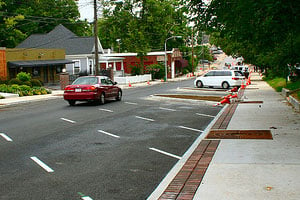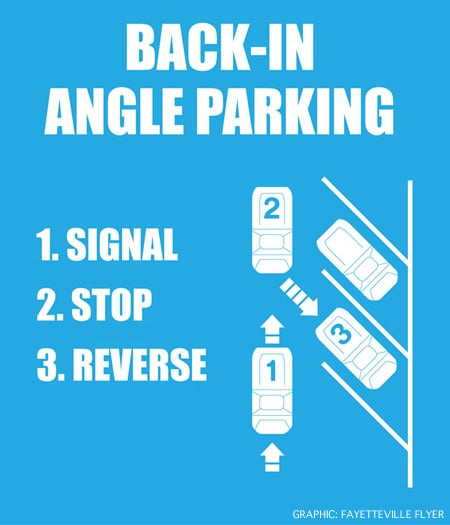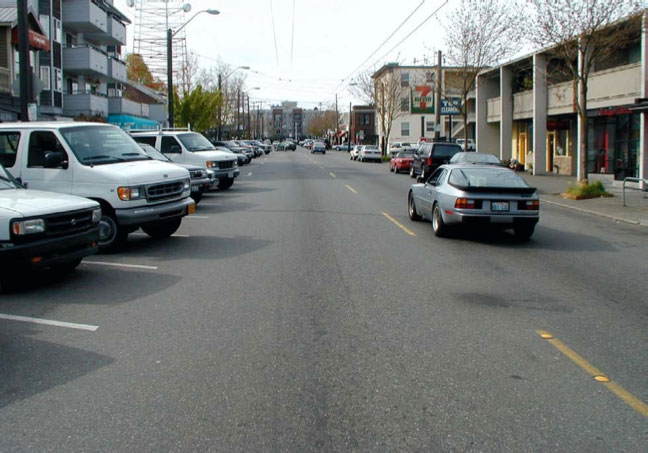City officials have said time and time again that the recent changes to Block Avenue will provide a safer, more pedestrian-friendly and aesthetically-pleasing link between Dickson Street and the downtown square. Ultimately, the city says the project will help to extend the regional draw of downtown Fayetteville.
For some, however, change isn’t always that easy to accept. Lack of instructional signage, narrowness of the driving lane, and frustration with having to learn how to use back-in parking were some of the specific complaints we saw here on the Flyer.
Some of those problems will be addressed said Jeremy Pate, director of Fayetteville development services. For example, the city plans to install “how-to” signs for those unfamiliar with back-in parking. But the overall concept and design of the project is for the best, he said.
While back-in parking may seem a little odd for anyone unfamiliar, Pate stressed that the same exact turning movements are required for pull-in angled parking. This concept is just in reverse, but with improved visibility.
Other safety benefits include easier loading of vehicles from the sidewalk versus the street and safer unloading of children, due to the fact that car doors open up and block access to the street, rather than the opposite.
Fayetteville is not the first to implement this concept. In fact, some cities have been using it for a long time.
According to a study by Nelson\Nygaard Consulting Associates, the city of Wilmington, Delaware has six blocks of 60 and 90-degree back-in angle parking dating back about 50 years. By city ordinance, Wilmington requires all angle parking to be back-in because of the safety factor. Other cities, like Seattle, Indianapolis and Washington, D.C., have been using back-in parking for 15-30 years.
The same study showed that there were 26 cities utilizing back-in parking as of 2005 and that the list is increasing steadily.
When hearing some of the complaints about the street design, Pate said the city did not overlook any design or safety basics.
“City engineers used standard engineering design practices to ensure emergency and delivery trucks can negotiate the intersections and drive lanes,” Pate said. “We also involved the fire department to designate fire staging zones at each block, along with loading zones for delivery vehicles.”
As for the narrowness of the road, that was done entirely on purpose. “It is true that the drive lanes are narrower than before, and motorists will have to slow down to negotiate the street,” said Pate. “That is precisely the point in the design, to reduce traffic speeds and make motorists aware of pedestrians. We used a similar approach on the Square, West Avenue and Dickson Street.”
Learning how to properly back into a parking spot will obviously be a learning process for anyone who’s never tried it. Pate said he believes it will catch on, though, and that some folks are already getting the hang of it.
“I happily observed that during an event at Goodfolk Productions last week, all of the angled spaces on the block were being used…correctly,” he said. Also, the transportation crews that are down there every day have communicated that most people figure it out pretty quickly, he added.
“It will certainly take getting used to something different on Block Avenue,” said Pate. “But, we truly believe it is for the best, and will improve the safety of all transportation types.”
» Back-in/Head-out Angle Parking study
Block Avenue construction timeline
By Mid August – Completion of sidewalk construction on the west side of Block Avenue
By Mid September – Completion of sidewalk construction on the east side of Block Avenue, and begin lighting installation
By the end of September – asphalt milling and street overlay, complete lighting installation
By Mid October – Install landscape islands Spring Street to Center Street
Installation of landscaping island plants and street trees will be completed as construction is completed and weather conditions allow.
Source: City of Fayetteville




